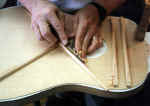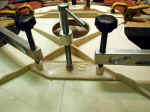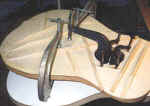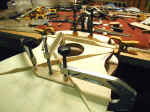Making the Top - 3
 Although the braces are partly shaped I do some finish carving
to "voice" the instrument. The final shape is more complex
than I can do on my spindle shaper, and besides I really enjoy this part
of the work. This is where I try to voice the guitar to the sound
my customer has requested. I do not want to suggest that this is
some science or fine art -- I think that guitarmakers have only the very
barest beginnings of understanding what makes a guitar sound the way it
does. Nonetheless, within certain limits, I -- and other guitar
makers -- feel that we can do some voicing to meet the needs of a particular
buyer. If I can't, well that's what the money back guarantee is
for.
Although the braces are partly shaped I do some finish carving
to "voice" the instrument. The final shape is more complex
than I can do on my spindle shaper, and besides I really enjoy this part
of the work. This is where I try to voice the guitar to the sound
my customer has requested. I do not want to suggest that this is
some science or fine art -- I think that guitarmakers have only the very
barest beginnings of understanding what makes a guitar sound the way it
does. Nonetheless, within certain limits, I -- and other guitar
makers -- feel that we can do some voicing to meet the needs of a particular
buyer. If I can't, well that's what the money back guarantee is
for.
 After sanding, the X braces are done.
After sanding, the X braces are done.
 More braces being glued in place.
More braces being glued in place.
Here, I am gluing the bridge plate in place as well as the small braces near the sound hole. Note the Plexiglas caul which I use to equalize the pressure of the clamps on the bridge plate. This piece is critical to the sound of the instrument and must be very carefully attached. My bridge plates are maple. Over the years I have occasionally used rosewood -- but wasn't happy with it -- and have varied the width of the bridge plate. I now use a plate about 1 3/4" wide and am happy with this. The maple is about .100" thick. The "sound hole braces" help to keep the vibrations in this important part of the top under control. The sound hole itself seems to destabilize the top here and these braces offset that effect. You will also note a small brace near the back of the top -- running from the rear transverse brace to the back of the guitar. I use this brace only on my larger guitars - dreadnought and jumbo shapes and find that it helps to balance the tendency of a these guitars to sound overly bassy or tubby. The next step will be building the back and then assembling the body.
 Gluing
in a bridge plate. Note the plexiglass caul to ensure even
clamping. I use hot hide glue for this step (all of the top
braces).
Gluing
in a bridge plate. Note the plexiglass caul to ensure even
clamping. I use hot hide glue for this step (all of the top
braces).
This website and all of its content, text and images are copyright ©1997-2011 by Charles A. Hoffman. All rights reserved.


